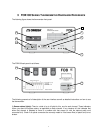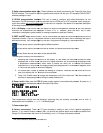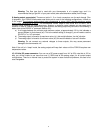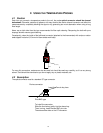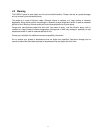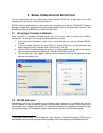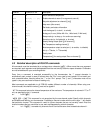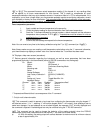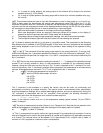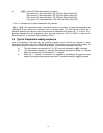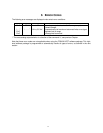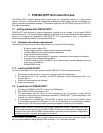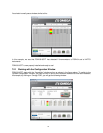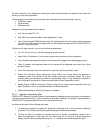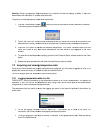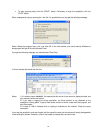15
b) i=1. In case of a probe problem, the analog output for this channel will be forced to its maximum
possible value (e.g., 10V or 20mA).
c) i=2. In case of a probe problem, the analog output will be forced to its minimum possible value (e.g.,
0V or 4mA).
“p[i]” This command allows the user to force the thermometer to enter in sleep mode (p+) or to exit it (p-).
Once in sleep mode, the thermometer will acquire new temperature values ONLY when the “t” or “t[i]”
command is received; when the t command is received, the thermometer will immediately scan all enabled
channels, and the new temperature values will be displayed and sent through the RS-232 link, after which it
will return again in sleep mode (there is no need to resend the p+ command again).
a) When the thermometer is powered on, the sleep mode is always disabled.
b) When new temperature values are acquired, these new values will be shown on the display (if
present) for about 40 seconds, after which “Sleep mode” will be displayed.
c) The analog outputs will keep the last temperature readings, until new ones become available.
d) The front panel led status lights will keep their values until new readings are acquired.
“q” “q” allows for selecting the fast (q+) or the slow (q-) acquisition mode. This is equivalent to the Sampling
Rate selection that is available on the FOB100 keypad. In slow mode, the last 4 temperatures are averaged
before being displayed or sent to the RS-232 port; this provides a better reading at the expense of being
slower.
“s[j]” or “s[i j]” This command will set the analog output span for the analog channel # i (if using a multi-
channel thermometer, the “i” parameter specifies the channel to which the command is addressed). The “j”
parameter specifies the span that can range from 1.0 to 1000.0, in temperature units that are defined by the
last “u” command.
“t” or “t[i]” Returns the current temperature reading for channel # i. “---.-” is displayed if the specified channel
number is not currently enabled or when no valid temperature is available for the requested channel.
However, during the initial warm-up time, the error “Err1” is sent in response to the “t” command. For multi-
channel instruments, if the “t” command is received without parameter, the temperatures for all channels are
returned. All temperatures are returned in
o
C or
o
F unit, as specified by the “u” command.
ex: “t4
E
“ will return the temperature for channel # 4.
“t
E
”, with the FOB104 thermometer, will return:
+24.3<CR>
+24.5<CR>
+24.7<CR>
+24.4<CR>
*
The “t” command is also available in a special “ta” version, that can be useful for continuously and
automatically monitoring all enabled channels. This special mode is recommended when automatically
acquiring temperature readings with a suitable data-logging software, and can be activated by issuing the
“ta+” command, or deactivated with the “ta-“ command. Once activated, the following information is
automatically sent when the temperature on a channel has been acquired:
“C:I;T: ±xxx.x<CR>”
where i is the channel number, and xxx.x is the temperature reading (signed number). For the FOB101
model, i is always 1.
“u[i]” Set units of measurements to either Celsius (i=c) or Fahrenheit (i=f). Note that this unit selection is the
same as the temperature unit selection made from the keypad (if the display option is installed).
ex: “uc
E
“, to select ºC (Celsius).
“y” The “y” command can be used to confirm the “signal strength” of a probe and/or its connection. It can be
used as a diagnostic tool to confirm the good operation of a probe and its patch cord (if applicable) connected
to a channel. The returned value can be between 0.3 to approximately 3.00; a higher value is better. A
minimum of 1.25 is required for a channel to return a temperature.



